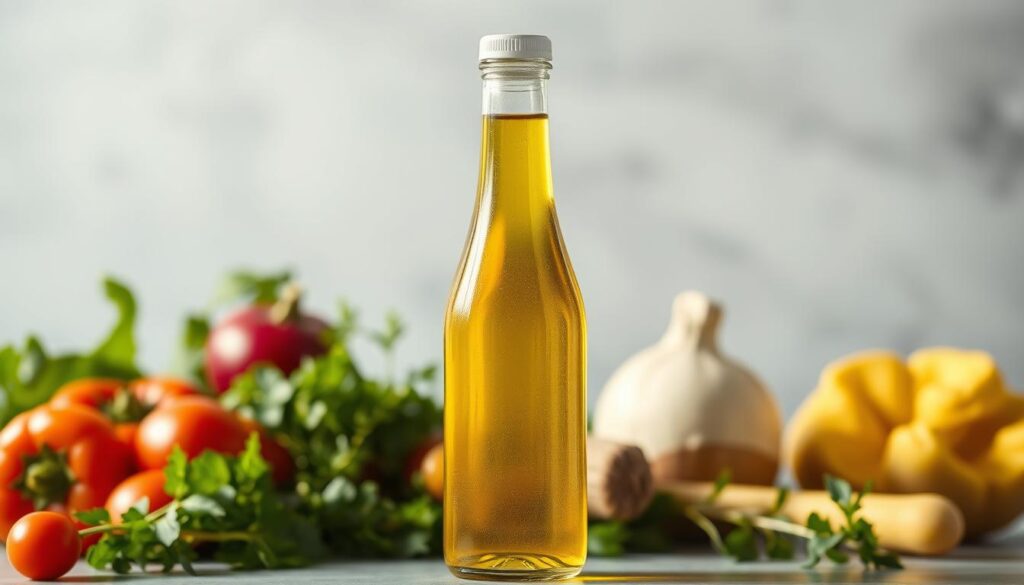Many people wonder about canola vs vegetable oil. Knowing the differences helps you choose the right oil for cooking. Canola oil is great for frying and baking because it has a high smoke point and less saturated fat.

Canola oil has more monounsaturated fat and omega-3s than vegetable oil. This is good for your cholesterol. Vegetable oil, made from soybean, corn, and sunflower oils, has a high smoke point. Think about what you need for cooking and nutrition when choosing between canola and vegetable oil.
Table of Contents
Introduction to Canola and Vegetable Oil
Canola oil and vegetable oil are two common cooking oils. Canola oil comes from canola seeds and tastes neutral. Vegetable oil is a mix of oils and also works well for many cooking methods. But canola oil is healthier because it has less saturated fat and more good fats.
Key Takeaways
- Canola oil has a high smoke point of 400°F, making it suitable for frying and baking.
- Vegetable oil is a blend of various oils, often with a higher saturated fat content.
- Canola oil is higher in monounsaturated fat and omega-3s compared to vegetable oil.
- Canola oil benefits include its low saturated fat content and high smoke point.
- Understanding the differences between canola and vegetable oil can help you make informed decisions about your cooking needs.
- Canola oil is a better choice for those looking to improve their cholesterol levels due to its high monounsaturated fat content.
Understanding the Basics of Cooking Oils
Choosing the right oil for cooking can be hard. There are many options, each with its own story. Canola oil and vegetable oil are two favorites, each with special canola oil benefits.
Canola oil comes from canola plants, mainly grown in Canada. It’s great for deep-frying and sautéing because of its high smoke point. Vegetable oil, on the other hand, is a mix of oils, with soybean oil being the most common. Its health benefits can change a lot because of this mix.

- Smoke point: Both canola oil and vegetable oil have a smoke point of 400°F.
- Origin: Canola oil is derived from canola plants, while vegetable oil is a blend of oils.
- Nutritional value: Canola oil contains a higher percentage of heart-healthy fats compared to vegetable oil.
Nutritional Profile: Canola vs Vegetable Oil
When we talk about canola oil vs vegetable oil nutrition, we see big differences. Canola oil is full of good fats. These fats can lower cholesterol and heart disease risk. To compare canola oil and vegetable oil, we must look at their nutrition.
Canola oil has 124 calories in one tablespoon. It has 14 grams of fat. This includes 1 gram of saturated fat, 9 grams of monounsaturated fat, and 4 grams of polyunsaturated fat.
Vegetable oil has 117 calories in one tablespoon. It has 13.6 grams of fat, with 11 grams of saturated fat. The American Diabetes Association suggests using sunflower, soybean, corn, or olive oil instead of hydrogenated oils. Here’s a comparison of the two oils:
| Oil Type | Calories per Tablespoon | Fat per Tablespoon | Saturated Fat per Tablespoon |
|---|---|---|---|
| Canola Oil | 124 | 14g | 1g |
| Vegetable Oil | 117 | 13.6g | 11g |
It’s key to look at the nutritional profiles of canola oil vs vegetable oil when choosing cooking oil. Canola oil is healthier because of its good fats and less saturated fat. To choose wisely, we must compare canola oil and vegetable oil and think about our nutritional needs and likes.
Smoke Points and Cooking Applications
Choosing the right oil for cooking is important. The smoke point of an oil is key. It’s the temperature when the oil starts to smoke. Canola oil works well for frying and baking because it has a smoke point of 400°F.
Vegetable oil is good for medium-heat cooking. Its smoke point varies, but it’s usually okay for sautéing.
Refined oils like avocado oil have higher smoke points. It can go up to 520°F, perfect for high-heat cooking. Safflower oil and peanut oil also have high smoke points. They’re great for frying and stir-frying.
But, oils like extra virgin olive oil and coconut oil are better for low heat. They’re good for finishing dishes. When picking an oil, think about the smoke point and how you’ll cook it. Canola oil or vegetable oil? It really depends on what you like and what you’re cooking.
Here’s a quick guide for cooking with different oils:
- Oils over 450°F are best for frying and broiling.
- Oils around 400°F are good for baking and browning.
- Oils in the 300°F range are okay for light sautéing.
- For salad oils, choose oils with smoke points around 225°F.
Health Benefits and Concerns
Canola oil and vegetable oil have different health benefits. Canola oil has less bad fat and more good fat. Studies show eating more good fat can make you healthier.
Canola oil is good for your heart because it has lots of good fat. Vegetable oil also has good fats, like omega-6s. These fats can lower bad cholesterol. But, eating too much oil can be bad for you.
Canola and vegetable oils have many health benefits. They can lower heart disease risk and improve insulin use. They also have vitamins E and K. It’s important to pick the right oil for your needs.
Cost Comparison and Availability
When looking at compare canola oil and vegetable oil, cost matters a lot. Both oils are easy to find in stores and online. Prices can change based on the brand and quality.
Think about the canola oil vs vegetable oil cooking temperature. This can affect how much you spend. Vegetable oil is usually cheaper than canola oil. But prices can go up and down all year.
Here are some important points to think about when comparing canola oil and vegetable oil:
- Canola oil costs between $3.59 and $4.59 for a 48 fluid oz bottle
- Vegetable oil costs between $3.18 and $4.39 for a 48 fluid oz bottle
- Both oils last about 1 year when stored right
When it comes to storing, keep both oils cool and dry. This helps them stay good for longer. Thinking about these things helps you choose the right oil for cooking.
Environmental Impact and Sustainability
Looking at canola oil vs vegetable oil, we see big differences. Vegetable oil’s big production harms the environment a lot. But canola oil is better because it uses less land and has less impact.
More and more people want vegetable oil. In 2020, we used about 219 million tons. By 2026, we’ll use around 285 million tons. This means more trees cut down and more pollution.
Canola oil is better for the planet than other oils. It makes less pollution than most vegetable oils. Soybean oil, for example, pollutes more than canola oil.
When picking oil, think about these things:
- Land use and deforestation
- Water consumption and pollution
- Greenhouse gas emissions and carbon footprint
- Yield per acre and crop efficiency
Choosing the right oil helps our planet. It makes our food choices better for the environment.
Taste and Flavor Profiles
When cooking, the taste of canola oil and vegetable oil matters a lot. Canola oil tastes neutral, which is great for many cooking ways. This lets the real flavors of food come out.
Vegetable oil tastes different based on the mix of oils. Both canola oil and vegetable oil are good for deep-frying, sautéing, baking, and grilling. They don’t add a strong taste that can hide other flavors.
Some vegetable oils have a lot of omega-6 fatty acids. Too much can upset the body’s balance. Canola oil has a better mix of fats and can handle high heat up to 400°F.
Choosing between canola oil and vegetable oil depends on what you like and how you cook. Knowing their tastes, uses, and health perks helps cooks pick the right oil for their dishes.
Best Uses in Different Cuisines
Choosing the right oil is key for great taste and texture in cooking. Canola oil and vegetable oil are both favorites, but they’re not the same. Canola oil is perfect for baking, frying, and salad dressings because it tastes neutral and can handle high heat.
Vegetable oil, on the other hand, is great for stir-fries, sautés, and roasts. It has a richer flavor and can handle heat well too.
Canola oil is a top pick for cooking because it’s good for frying and has less bad fat. It’s also better for your heart because it’s full of good fats and vitamins E and K.
Here are some key things to think about when picking between canola oil and vegetable oil:
- Smoke point: Canola oil can handle more heat than vegetable oil, making it better for high-heat cooking.
- Flavor: Canola oil tastes neutral, while vegetable oil can taste stronger, depending on the mix.
- Saturated fat content: Canola oil has less bad fat than vegetable oil, making it a healthier choice.
So, whether to use canola oil or vegetable oil depends on what you’re cooking and what you like. Knowing the good and bad of each oil helps you pick the best one for your next meal.
Conclusion: Making the Right Choice for Your Cooking Needs
Choosing the right cooking oil is important. Both canola oil and vegetable oil have good points. Canola oil is healthier because it has less bad fat and is good for many cooking ways.
Vegetable oil is easy to find and costs about the same as canola oil. It’s great for many home cooks.
So, which one is better? It depends on what you need and like. If you want healthy fats and can use it in many ways, canola oil is good.
If you care more about saving money and it’s easy to find, vegetable oil works well. Knowing the differences helps you choose the best oil for you.
FAQ
What is the difference between canola oil and vegetable oil?
Canola oil comes from canola seeds. It tastes neutral and works well for many cooking methods. Vegetable oil is a mix of oils like soybean and sunflower. It also tastes neutral and works well for cooking.
What are the origins and processing methods for canola oil and vegetable oil?
Canola oil comes from rapeseed plants. It’s refined to make it taste better and cleaner. Vegetable oil is made from different oils. The making process can change based on the mix and who makes it.
How do the nutritional profiles of canola oil and vegetable oil differ?
Canola oil has good fats that help your heart. Vegetable oil’s nutrition can change based on its mix. But, it often has more bad fats than canola oil.
What are the smoke points of canola oil and vegetable oil, and how does this impact their cooking applications?
Canola oil can handle high heat, great for frying and baking. Vegetable oil works best for medium heat, like stir-frying.
What are the health benefits and concerns associated with canola oil and vegetable oil?
Canola oil is better for your heart because of its fats. Vegetable oil’s health impact varies. But, it often has more bad fats than canola oil.
How do the cost and availability of canola oil and vegetable oil compare?
You can find both oils in stores and online. Prices can differ, but they’re often similar. Canola oil might be a better deal for a healthier choice.
What are the environmental impacts and sustainability considerations for canola oil and vegetable oil?
Canola oil is better for the planet because it’s more sustainable. Vegetable oil’s impact can vary based on how it’s made.
How do the taste and flavor profiles of canola oil and vegetable oil differ?
Canola oil tastes neutral, good for many dishes. Vegetable oil’s taste can change based on its mix. But, it’s often neutral too, making it versatile.
What are the best uses for canola oil and vegetable oil in different cuisines?
Use canola oil for baking, frying, and dressings. Vegetable oil is great for stir-frying, sautéing, and roasting.







